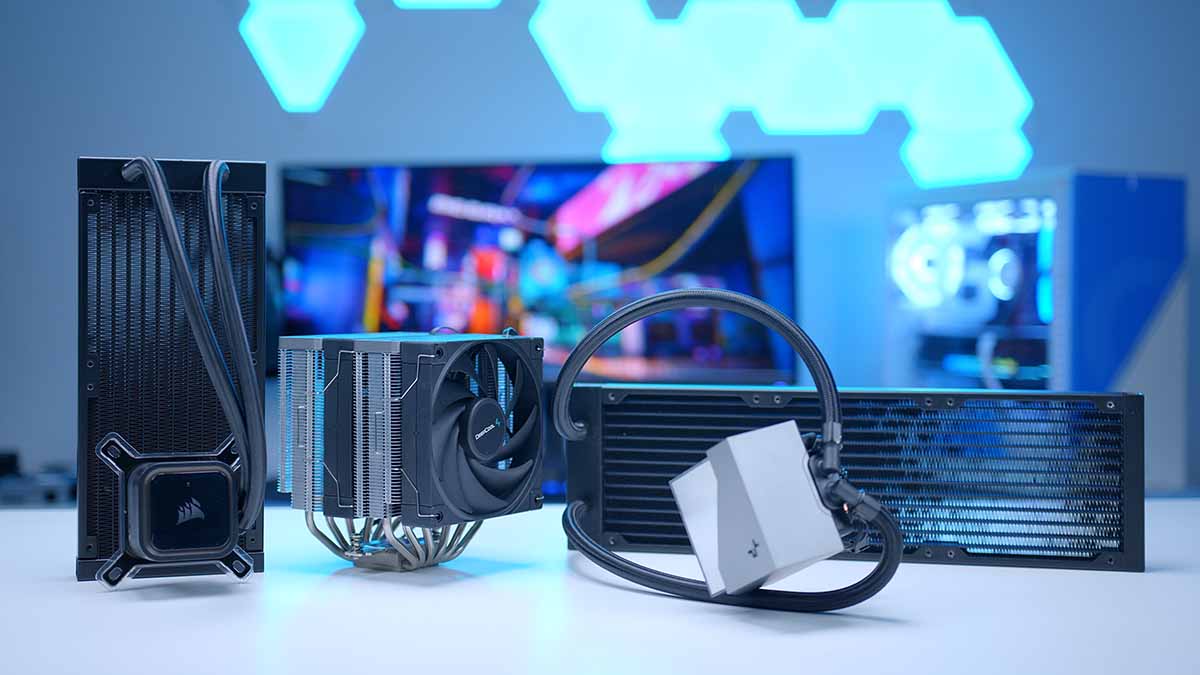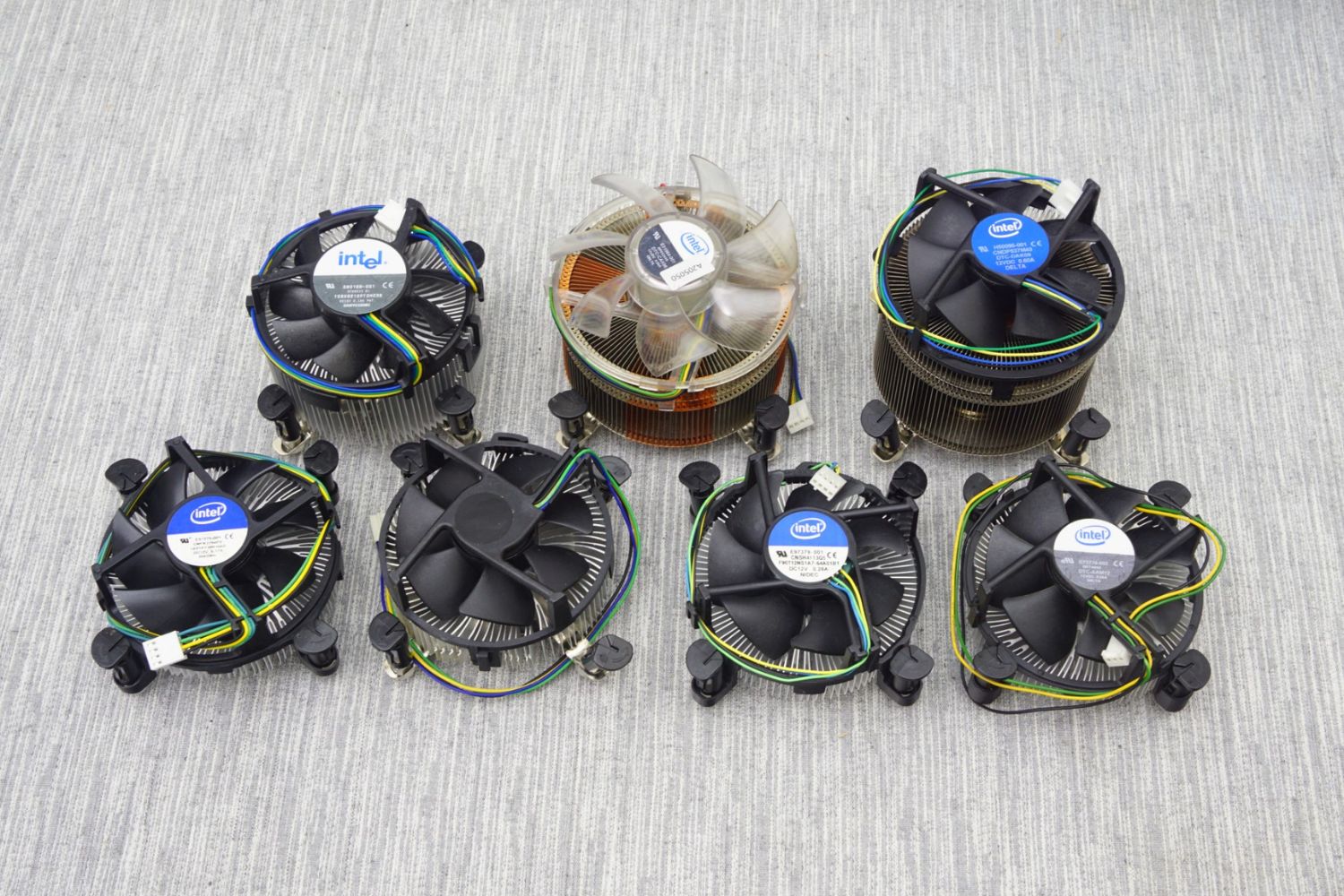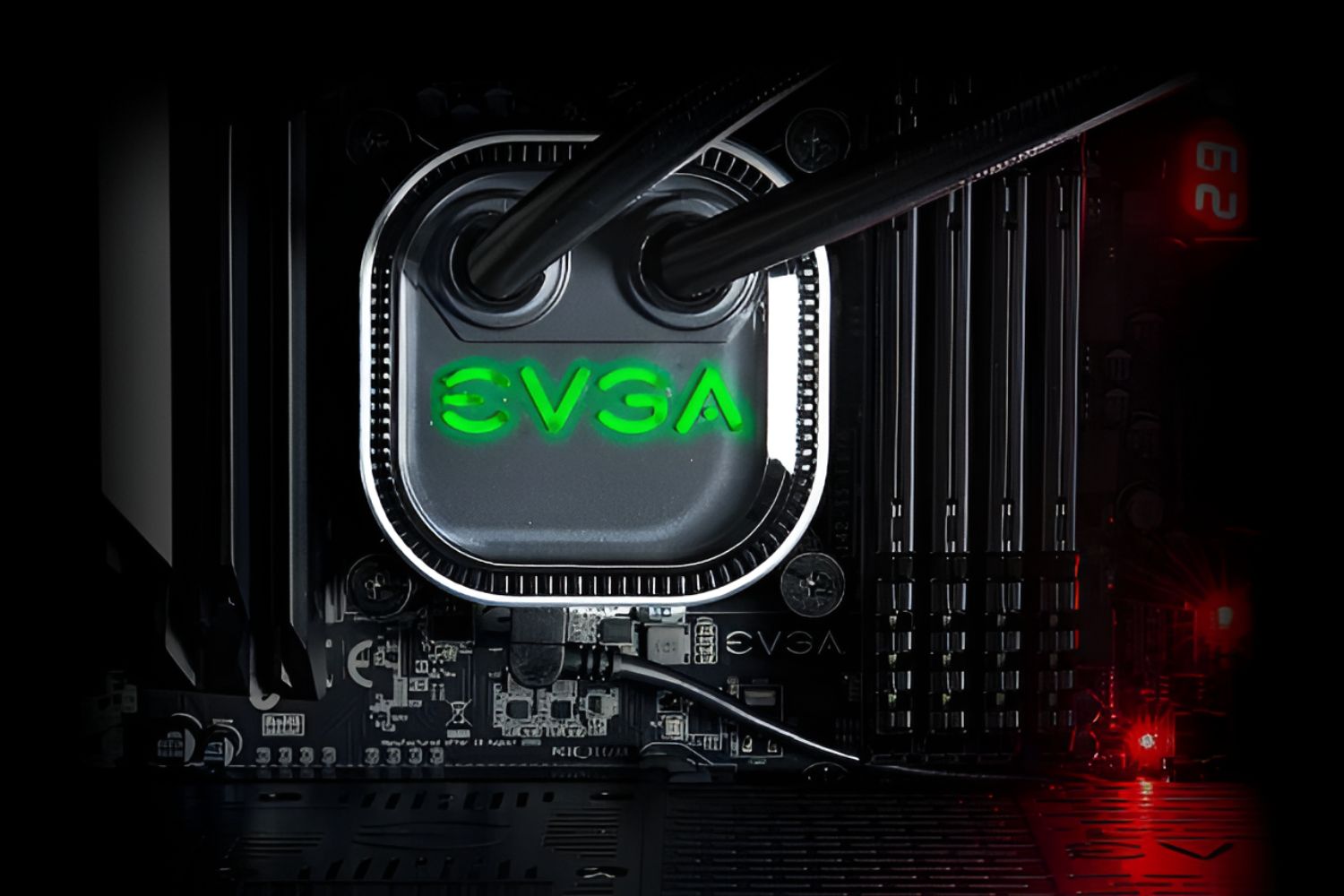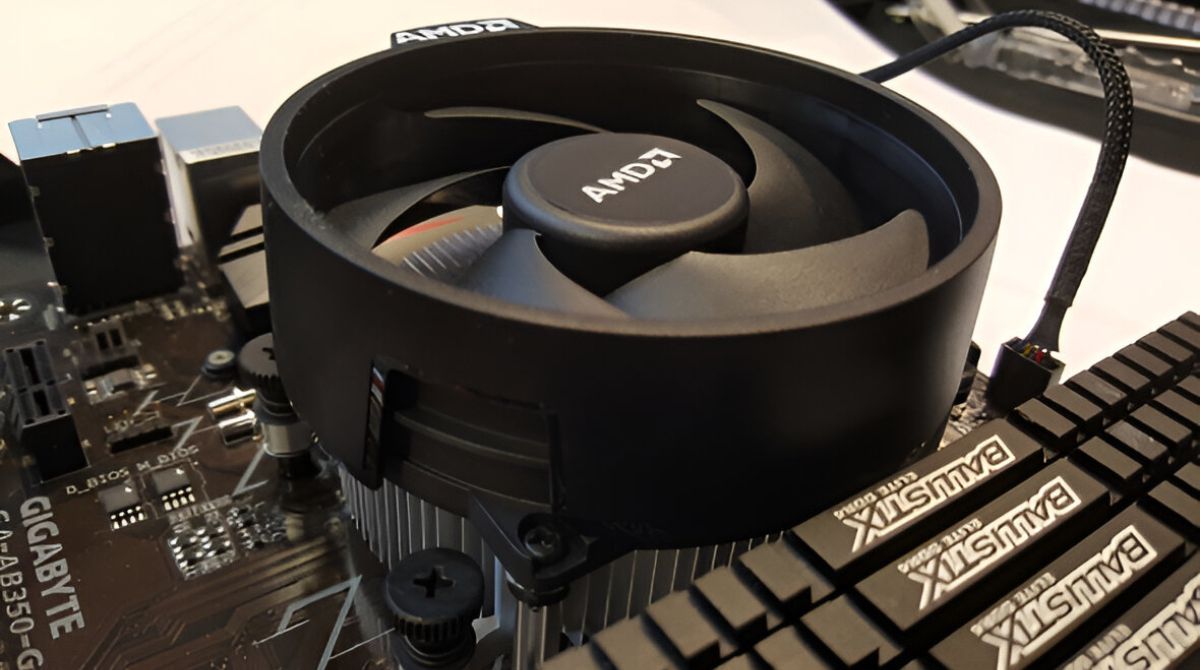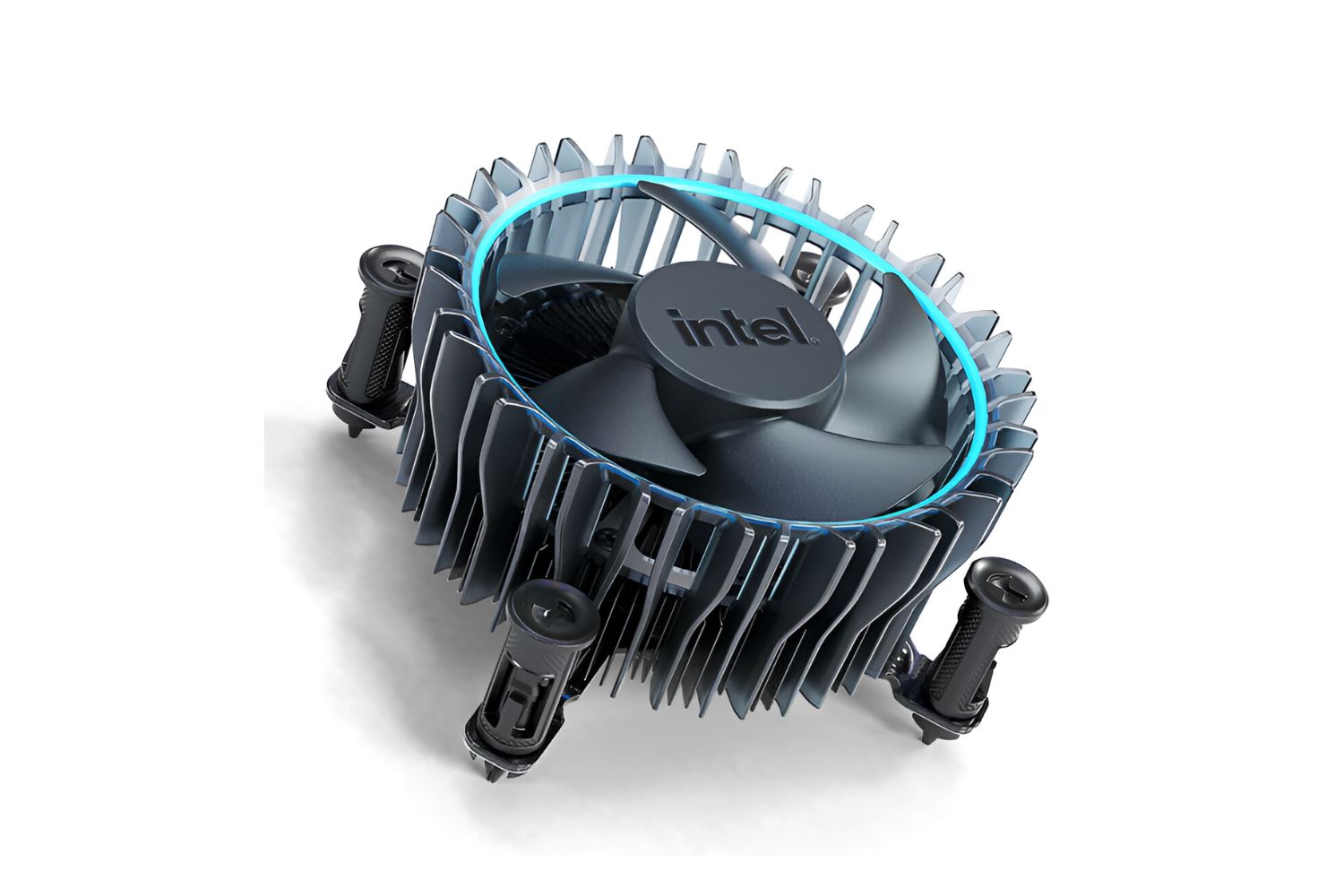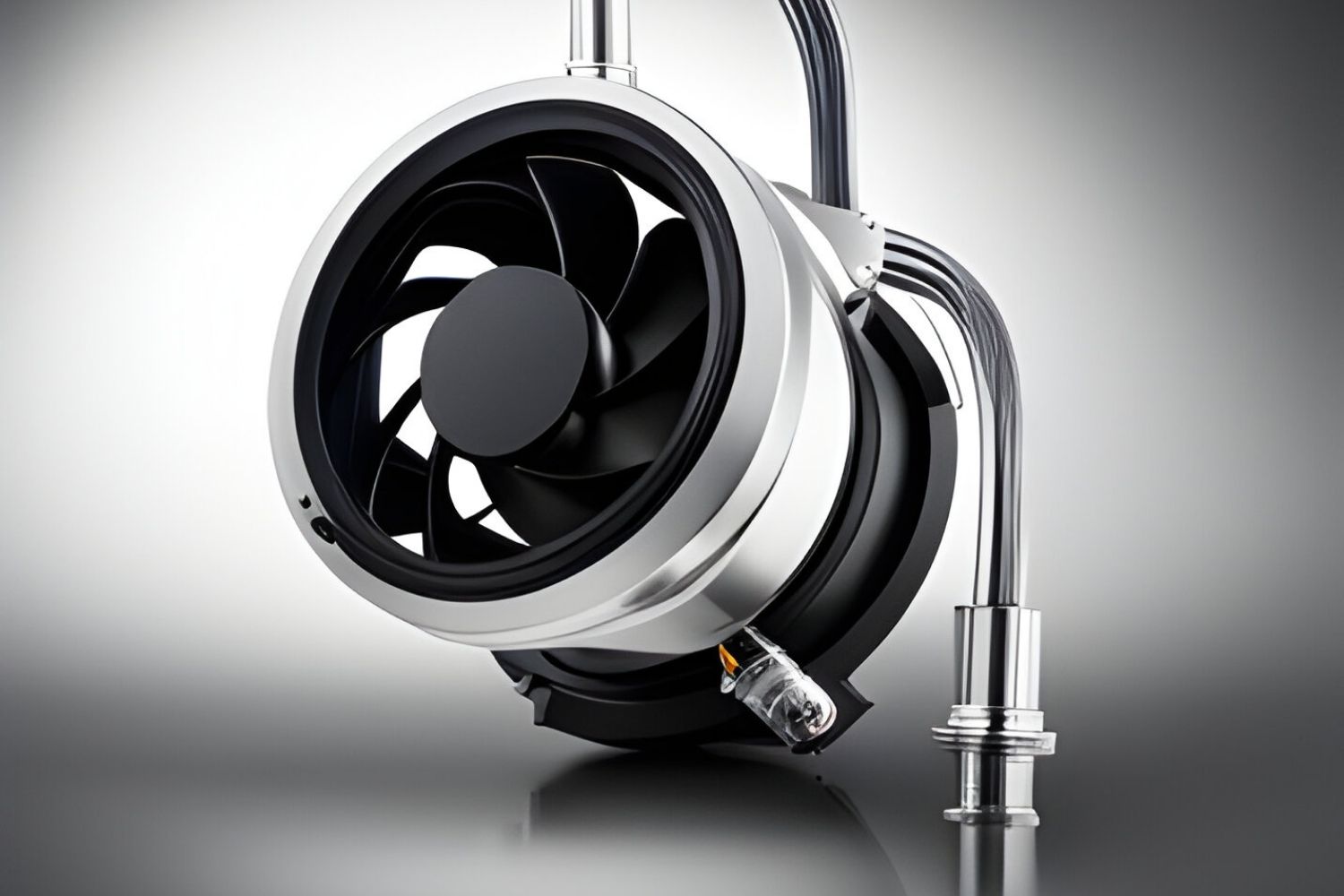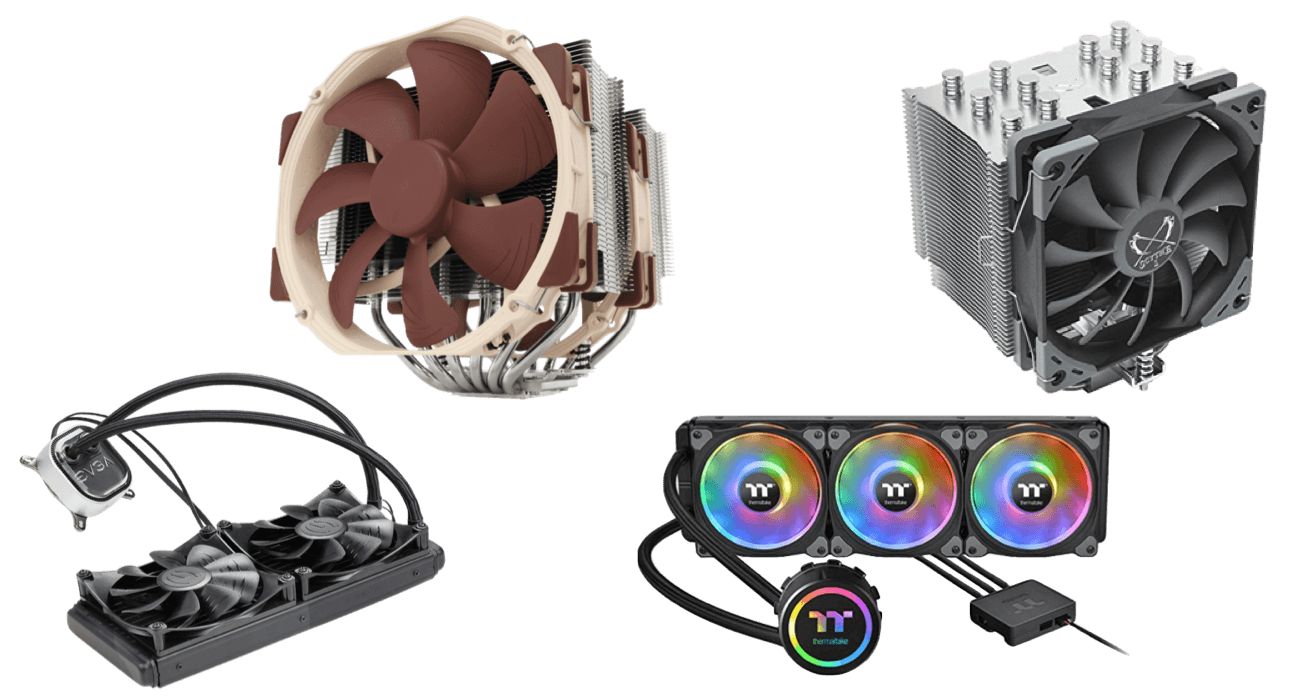Introduction
When it comes to building or upgrading a computer, selecting the right CPU cooler is an essential consideration. A CPU cooler plays a crucial role in maintaining the optimal temperature of your processor, ensuring its longevity, and preventing thermal throttling that can hamper performance.
Whether you are a casual user, a professional gamer, or a heavy multitasker, investing in a quality CPU cooler is a wise decision. It not only helps to regulate the temperature of your CPU but also contributes to overall system stability and longevity.
However, with the vast array of options available in the market, finding the right CPU cooler that suits your needs and budget can be daunting. Should you go for a budget-friendly cooler that gets the job done, or do you need a high-end cooler with advanced features for extensive overclocking? The answer depends on your specific requirements, preferences, and budget.
In this article, we will explore the different factors to consider when choosing a CPU cooler and help you make an informed decision about how much money you should spend on this crucial component. Whether you are a novice builder or an experienced enthusiast, by the end of this article, you will have a clearer understanding of the options available at different price points and which one best suits your needs.
So, let’s dive in and explore the world of CPU coolers, discover the best options within different budgets, and find the ideal balance between performance and price.
Importance of a CPU Cooler
A CPU cooler is an essential component in any computer system. It is responsible for dissipating the heat generated by the Central Processing Unit (CPU) during operation. Without an effective CPU cooler, the processor can overheat, leading to performance issues, system instability, and potentially permanent damage.
Why is maintaining the optimal temperature of the CPU so crucial? Well, when a processor operates, it generates heat as a result of the electrical energy being converted into computational power. As the number of transistors packed onto a CPU increases, so does the amount of heat generated.
When a CPU becomes too hot, it can trigger a thermal throttling mechanism, causing the processor to reduce its clock speed to dissipate heat and prevent damage. This leads to decreased performance and slower response times, affecting the overall functionality of your computer.
Over time, prolonged exposure to high temperatures can also shorten the lifespan of your CPU. Heat can cause the delicate microcircuits within the processor to degrade and eventually fail. By investing in a reliable CPU cooler, you can ensure that your processor operates within safe temperature ranges and enjoys a longer lifespan.
Besides maintaining optimal operating temperatures, a CPU cooler can contribute to overall system stability. High temperatures can affect the stability of other components, such as the motherboard and graphics card. By keeping the CPU cool, you minimize the risk of system crashes, freezes, and other performance issues.
Furthermore, a CPU cooler plays a critical role in enabling overclocking. Overclocking refers to the process of running a processor at a higher clock speed than the manufacturer’s specifications. This can provide a significant performance boost in certain applications, such as gaming and video editing. However, overclocking also generates more heat, requiring a robust CPU cooler to keep temperatures in check.
Overall, investing in a quality CPU cooler is crucial to ensure the longevity, performance, and stability of your computer system. It is an essential component for any gamer, content creator, or heavy computer user who demands high performance and reliability.
Factors to Consider when Choosing a CPU Cooler
When it comes to selecting a CPU cooler, there are several key factors to keep in mind. Each factor plays a significant role in determining the performance, compatibility, and overall suitability of the cooler for your specific system. Let’s take a closer look at these factors:
- Processor Compatibility: It is crucial to ensure that the CPU cooler you choose is compatible with your processor socket type. Different processors use different socket designs, such as Intel’s LGA or AMD’s AM4. Checking the compatibility of the cooler with your specific processor is essential to ensure proper installation and cooling performance.
- Cooler Size: The size of the CPU cooler is another important consideration. It should fit comfortably within your computer case without obstructing other components. Make sure to measure the available clearance in your case and check the dimensions of the cooler to ensure a proper fit.
- Heat Dissipation Method: CPU coolers can employ various methods to dissipate heat, including air cooling and liquid cooling. Air coolers use fans and heatsinks to draw heat away from the processor, while liquid coolers use a pump, radiator, and liquid coolant to transfer heat. Consider your cooling needs, space constraints, and personal preferences when choosing between these cooling methods.
- Cooler Performance: The cooling performance of a CPU cooler is measured by its thermal dissipation capabilities, expressed in terms of its maximum TDP (Thermal Design Power) rating. Higher TDP ratings indicate better cooling performance. Consider the cooling requirements of your processor and the level of heat generated during regular usage or overclocking to select a cooler with sufficient cooling capacity.
- Noise Level: The noise produced by the CPU cooler’s fans can impact the overall acoustic profile of your computer. Consider the noise level specified by the manufacturer and look for coolers with low noise ratings if a quiet system is important to you.
- Price: Your budget is an important factor when selecting a CPU cooler. Establish a price range that suits your financial constraints and look for coolers that offer a good balance between price and performance within that range. Remember, higher-priced coolers tend to offer better cooling performance and additional features.
- Build Quality and Durability: Consider the build quality of the CPU cooler and the materials used in its construction. A well-built cooler with durable components will not only provide better cooling performance but also last longer, ensuring a reliable cooling solution for your system.
- Additional Features: Some CPU coolers come with extra features such as RGB lighting, fan speed control, or software integration. While these features do not directly impact cooling performance, they can enhance the aesthetics and customization options of your system.
By considering these factors, you can make an informed decision when selecting a CPU cooler that meets your specific requirements, offers optimal cooling performance, and fits within your budget. Next, we will explore budget-friendly, mid-range, and high-end CPU cooler options to help you find the best fit for your needs.
Budget-Friendly CPU Coolers
If you’re working with a tight budget but still want to ensure proper cooling for your processor, there are several budget-friendly CPU cooler options available that offer good performance without breaking the bank. These coolers are typically aimed at casual users, office systems, or entry-level gaming rigs. Let’s take a look at some popular budget-friendly CPU coolers:
- Cooler Master Hyper 212 EVO: Considered a classic, the Cooler Master Hyper 212 EVO is a highly regarded air cooler that offers excellent cooling performance at an affordable price. It features four direct contact heat pipes, a 120mm fan, and a user-friendly installation process. The Hyper 212 EVO is compatible with a wide range of sockets and provides efficient cooling for most mainstream processors.
- CRYORIG H7: The CRYORIG H7 is another popular budget-friendly cooler known for its compact size and impressive cooling capability. It features a tower-style design with three 6mm heat pipes, a 120mm fan, and a low noise level. The H7 is compatible with various CPU sockets and offers a great balance between performance and affordability.
- ARCTIC Freezer 34 eSports DUO: The ARCTIC Freezer 34 eSports DUO offers an excellent price-to-performance ratio with its dual-fan design and high-quality build. The cooler features four 6mm heat pipes, two 120mm fans, and a stylish design with customizable color accents. It is compatible with most mainstream sockets and provides efficient cooling for mid-range processors.
- Noctua NH-L9i: If you are building a small form factor or HTPC system and need a low-profile cooler, the Noctua NH-L9i is a popular choice. Despite its compact size, it offers sufficient cooling performance for low to moderate power processors. The NH-L9i features a 92mm fan, a slim heatsink, and a quiet operation that makes it suitable for noise-sensitive environments.
- Deepcool GAMMAXX 400: The Deepcool GAMMAXX 400 is a budget-friendly air cooler that provides reliable cooling for mid-range systems. It features four 6mm copper heat pipes, a 120mm fan, and a blue LED lighting effect. The GAMMAXX 400 is compatible with a wide range of sockets and offers a great combination of cooling performance and value for money.
These budget-friendly CPU coolers provide efficient cooling solutions without straining your wallet. While they may not offer the same level of performance or advanced features as higher-end options, they are more than capable of keeping your processor temperatures in check under normal operating conditions.
Remember to consider factors such as processor compatibility, cooler size, and noise levels when choosing a budget cooler. Ensure that the cooler fits your specific requirements and offers the necessary cooling capacity for your processor. With these budget-friendly options, you can achieve adequate cooling for your system without compromising on affordability or performance.
Mid-Range CPU Coolers
If you’re willing to spend a bit more for enhanced cooling performance and additional features, mid-range CPU coolers offer a great balance between affordability and functionality. These coolers are suitable for gamers, content creators, and users who desire better cooling capacity and overclocking potential. Let’s explore some popular mid-range CPU coolers:
- Noctua NH-D15: The Noctua NH-D15 is a flagship air cooler known for its exceptional cooling performance and build quality. It features dual tower heatsinks, six heat pipes, and two premium grade 140mm fans. The NH-D15 offers excellent thermal dissipation, low noise levels, and compatibility with various socket types, making it a top choice for enthusiasts.
- Cooler Master MasterLiquid ML240L V2: If you prefer liquid cooling, the Cooler Master MasterLiquid ML240L V2 is a popular mid-range option. It features a 240mm radiator, dual 120mm fans, and efficient cooling performance. The ML240L V2 boasts a sleek design, customizable RGB lighting, and compatibility with a wide range of processor sockets.
- be quiet! Dark Rock Pro 4: The be quiet! Dark Rock Pro 4 is an impressive air cooler designed for both performance and aesthetics. It features a dual tower heatsink, seven heat pipes, and two 120mm SilentWings fans. The Dark Rock Pro 4 offers excellent cooling capabilities, low noise levels, and a striking black design that complements any system build.
- Corsair iCUE H100i RGB Pro XT: Corsair is renowned for its high-quality cooling solutions, and the iCUE H100i RGB Pro XT is no exception. This liquid cooler features a 240mm radiator, dual 120mm PWM fans, and dynamic RGB lighting. It offers excellent cooling performance, advanced fan control, and compatibility with major processor sockets.
- Deepcool Assassin III: The Deepcool Assassin III is a massive air cooler that delivers superior cooling performance for enthusiasts. It features twin tower heatsinks, seven heat pipes, and two 140mm fans. The Assassin III offers exceptional thermal dissipation, a sleek black design, and compatibility with a range of sockets, making it an ideal choice for overclocking enthusiasts.
These mid-range CPU coolers provide a significant step up in performance compared to budget options. They offer better thermal dissipation, improved overclocking potential, and often come with additional features such as RGB lighting and fan control. They strike a balance between price and performance, making them suitable for users who demand more from their cooling solution.
Remember to consider factors such as compatibility, cooling performance, noise levels, and any specific requirements you may have when choosing a mid-range cooler. These coolers are designed to handle the demands of gaming, content creation, and heavy multitasking, offering a reliable and efficient cooling solution for your system.
High-End CPU Coolers
For users who require the utmost cooling performance and advanced features, high-end CPU coolers offer top-of-the-line solutions. These coolers are designed for enthusiasts, overclockers, and power users who demand the best cooling capabilities available. Let’s explore some popular high-end CPU coolers:
- NZXT Kraken X73: The NZXT Kraken X73 is a top-tier all-in-one liquid cooler that combines exceptional cooling performance with stunning aesthetics. It features a 360mm radiator, three Aer P 120mm fans, and advanced CAM software control. The Kraken X73 offers excellent thermal dissipation, quiet operation, customizable RGB lighting, and compatibility with major CPU sockets.
- CORSAIR iCUE H150i ELITE CAPELLIX: The CORSAIR iCUE H150i ELITE CAPELLIX is a high-performance liquid cooler that features a 360mm radiator, three ML120 PRO RGB fans, and advanced iCUE software integration. This cooler offers powerful thermal performance, customizable RGB lighting effects, advanced fan control, and compatibility with popular CPU sockets.
- Noctua NH-D15S chromax.black: Noctua’s NH-D15S chromax.black is a premium air cooler known for its cutting-edge performance and sleek design. It features a single tower heatsink, six heat pipes, and two NF-A15 PWM fans. The NH-D15S chromax.black offers exceptional cooling efficiency, reduced noise levels, and compatibility with various sockets.
- EK-AIO 360 D-RGB: The EK-AIO 360 D-RGB combines high-performance liquid cooling with customizable RGB lighting effects. It features a 360mm radiator and three Vardar S 120ER D-RGB fans. The EK-AIO 360 D-RGB offers excellent cooling capacity, precise fan control, and seamless integration with popular CPU sockets.
- Thermalright Silver Arrow TR4: Designed specifically for AMD’s Threadripper processors, the Thermalright Silver Arrow TR4 is a high-end air cooler known for its exceptional cooling performance. It features dual tower heatsinks, eight heat pipes, and two TY-143 140mm PWM fans. The Silver Arrow TR4 offers outstanding thermal dissipation, low noise levels, and compatibility with the Threadripper socket.
These high-end CPU coolers represent the pinnacle of cooling performance and offer an array of advanced features for enthusiasts. They excel at dissipating heat, ensuring stable performance during intense workloads or extreme overclocking. With their robust designs, superior components, and enhanced cooling capabilities, these coolers are ideal for users who demand the best cooling performance available.
When considering high-end CPU coolers, be sure to carefully review compatibility, cooling capacity, noise levels, and any specific requirements you may have. These coolers are designed to deliver exceptional performance and often come with additional features such as advanced software control, RGB lighting, and durable construction.
Performance vs Price: Finding the Right Balance
When choosing a CPU cooler, finding the right balance between performance and price is crucial. While high-end coolers offer top-of-the-line performance and advanced features, they often come with a higher price tag. On the other hand, budget-friendly coolers provide affordable cooling solutions but may not have the same level of performance or additional features. It’s important to consider your specific needs, budget, and the cooling demands of your system.
For casual users, office systems, or entry-level gaming rigs, a budget-friendly CPU cooler can provide adequate cooling performance. These coolers are designed to handle the thermal demands of mainstream processors without putting a strain on your wallet. While they may not offer the same overclocking potential or advanced features as high-end options, they can reliably keep your CPU temperatures in check under normal operating conditions.
Mid-range CPU coolers offer a step up in performance and additional features over their budget counterparts. They are suitable for gamers, content creators, and users who require better cooling capacity and overclocking potential. Mid-range coolers strike a balance between price and performance, offering improved thermal dissipation and often incorporating features such as RGB lighting, fan control, and better build quality.
For enthusiasts, overclockers, and power users who demand the absolute best cooling performance, high-end CPU coolers are the go-to choice. These coolers provide exceptional thermal dissipation, advanced features, and top-tier components. They are designed to handle extreme overclocking and high computational workloads, ensuring that your processor stays at optimal temperatures even under heavy usage.
While high-end coolers can provide unrivaled performance, it’s important to note that the benefits they offer may not always justify the price premium for every user. Consider your specific needs and the cooling demands of your system to determine if the additional performance and features of a high-end cooler are necessary.
Ultimately, finding the right balance between performance and price is a personal decision. Assess your cooling needs, budget constraints, and desired features to select a CPU cooler that provides the optimal cooling solution for your specific requirements. Whether you choose a budget-friendly cooler, a mid-range option, or a high-end powerhouse, make sure it meets your cooling needs efficiently and fits within your budgetary considerations.
Overclocking Potential with Different CPU Coolers
Overclocking refers to running a processor at a higher clock speed than its default specifications. It can provide a significant performance boost in tasks that are CPU-intensive, such as gaming, video editing, or 3D rendering. When considering overclocking, the choice of CPU cooler plays a crucial role in managing temperatures and maintaining stability. Different CPU coolers have varying capacities for handling the increased heat generated by overclocking. Let’s explore the overclocking potential of different CPU coolers:
1. Budget-Friendly Coolers: Budget-friendly coolers, while capable of maintaining stable temperatures for normal operating conditions, generally have limited overclocking potential. These coolers are designed for casual users and may struggle to handle the additional heat generated by aggressive overclocking. If you plan to overclock your processor, it is advisable to consider a cooler with better thermal dissipation capabilities.
2. Mid-Range Coolers: Mid-range CPU coolers typically offer better cooling performance than budget options, making them suitable for moderate overclocking. They have larger heatsinks, more heat pipes, and better fan designs, allowing them to handle increased heat effectively. These coolers can provide stable temperatures and decent overclocking potential for processors with moderate power requirements.
3. High-End Coolers: High-end CPU coolers are designed to handle extreme overclocking and provide the best thermal performance. With larger heatsinks, multiple heat pipes, and high-quality fans, these coolers can dissipate heat effectively even under heavy overclocking. They offer the most headroom for pushing the limits of your processor’s clock speeds. If you are an enthusiast or power user looking to extract every ounce of performance from your CPU, investing in a high-end cooler is essential.
When overclocking, it’s important to note that stability is key. Each processor has different overclocking capabilities and will reach different clock speeds based on its individual characteristics. While a more capable cooler can help dissipate heat, the success of overclocking also depends on the quality of the CPU itself.
When overclocking your CPU, ensure that you monitor temperatures closely and gradually increase clock speeds while stress testing the system for stability. If temperatures rise to unsafe levels or the system becomes unstable, it is crucial to dial back the overclock or upgrade to a more powerful cooling solution.
Remember that overclocking may put additional stress on your processor and potentially void its warranty. Consider the potential risks and benefits before proceeding, and always follow safe overclocking practices and guidelines provided by your CPU manufacturer.
In summary, choosing the right CPU cooler for overclocking is crucial for maintaining stable temperatures and maximizing performance. Budget-friendly coolers offer limited overclocking potential, mid-range coolers provide a moderate level of overclocking capability, and high-end coolers excel at handling extreme overclocking. Select a cooler based on your specific overclocking goals, the capabilities of your processor, and your budget.
Noise Level Considerations
When choosing a CPU cooler, one important factor to consider is the noise level produced by the cooler’s fans. Noise can significantly impact the overall user experience, especially for those who value a quiet and peaceful computing environment. Different CPU coolers have varying noise levels, and finding a balance between cooling performance and noise is crucial. Let’s delve into noise level considerations when selecting a CPU cooler:
1. Fan Design: The design of the fans used in the CPU cooler can greatly affect the noise level. Look for coolers with fans that are specifically engineered for quiet operation. Features such as low-noise bearings, advanced blade designs, and rubber dampeners can help reduce noise by minimizing vibrations and airflow turbulence.
2. Noise Rating: Manufacturers often provide a noise rating for their CPU coolers, typically in decibels (dB). The lower the dB rating, the quieter the cooler will be. Consider coolers with lower noise ratings if having a whisper-quiet system is important to you.
3. Fan Speed Control: CPU coolers with fan speed control options allow you to adjust the fan speeds manually or automatically based on system temperature. This can help you strike a balance between cooling performance and noise level. By reducing the fan speed when the CPU is under low load or operating at lower temperatures, you can achieve quieter operation without compromising cooling efficiency.
4. Heat Sink Design: The design and construction of the heat sink can also influence noise levels. Larger heat sinks with more surface area can dissipate heat more effectively, allowing fans to run at lower speeds and produce less noise. Additionally, heat sinks with more heat pipes and better heat transfer capabilities can help keep temperatures lower, potentially reducing the need for faster fan speeds.
5. Personal Preferences: Noise tolerance varies from person to person. Some individuals may be more sensitive to noise and require a nearly silent system, while others may not mind a moderate level of noise. Consider your personal preferences and the environment in which your computer will be used when choosing a CPU cooler. If noise reduction is a top priority, investing in a high-quality, low-noise cooler may be worth considering.
Remember that cooling performance and noise level often go hand in hand. Cooler fans with high RPMs tend to provide better cooling, but may produce more noise. Finding the right balance between cooling efficiency and noise level is essential to create a comfortable and enjoyable computing experience.
Reading reviews and user feedback can provide valuable insights into the noise levels of specific CPU coolers. Take the time to research and select a cooler that aligns with your noise level preferences and cooling requirements.
Ultimately, noise level considerations are crucial for creating a pleasant and peaceful computing experience. By choosing a CPU cooler with a low noise rating, fan speed control options, and a well-designed heat sink, you can enjoy efficient cooling while keeping noise levels at a minimum.
Compatibility with Your System
When selecting a CPU cooler, it is essential to consider the compatibility of the cooler with your specific system. Compatibility factors include the socket type of your processor, the physical dimensions of the cooler, and any potential clearance issues within your computer case. Ensuring compatibility will help you avoid installation problems and ensure optimal cooling performance. Let’s explore the compatibility considerations when choosing a CPU cooler:
1. Processor Socket Compatibility: Different processors utilize different socket designs, such as Intel’s LGA (Land Grid Array) or AMD’s AM4. It is crucial to determine if the CPU cooler is compatible with the socket type of your processor. Manufacturers usually provide information about compatible sockets on their product pages. Verify the compatibility with your processor’s socket before purchasing a CPU cooler to ensure a proper fit and installation.
2. Cooler Size and Clearance: The physical dimensions of the CPU cooler play a vital role in compatibility. Measure the available space within your computer case to determine if the cooler will fit comfortably without obstructing other components such as RAM modules, graphics cards, or motherboard heatsinks. Take note of the cooler’s height, width, and length, also considering any additional clearance required for fans or radiator installation.
3. Cooler Mounting Mechanism: Different CPU coolers may have different mounting mechanisms, such as brackets or backplates. Ensure that the cooler’s mounting mechanism is compatible with your motherboard to ensure a secure and stable installation. Check the documentation provided by the cooler manufacturer and verify the compatibility with your specific motherboard model.
4. RAM Clearance: Certain CPU coolers, especially those with large heatsinks or fans, can obstruct the space above the RAM slots. Consider the height and positioning of your RAM modules when choosing a cooler to ensure that they will not interfere with each other. Some coolers offer adjustable fan or heatsink positions to accommodate varying RAM heights.
5. Power Clearance: High-performance coolers, especially those with large heatsinks, may impact the positioning and accessibility of power connectors on the motherboard. Ensure that the cooler does not block or hinder the connection of power cables, especially in smaller form factor systems where space is limited.
6. Pre-built System Considerations: If you are using a pre-built system, such as a laptop or an all-in-one PC, compatibility options may be limited. In these cases, check with the manufacturer or consult your system’s documentation to determine if CPU cooler upgrades or modifications are possible.
Paying careful attention to compatibility ensures a hassle-free installation process and maximizes the cooling efficiency of your CPU cooler. Always review the specifications and documentation provided by the cooler manufacturer and consult your system’s documentation or manufacturer if needed. If you are unsure about compatibility, reaching out to tech support or seeking advice from fellow users can provide additional guidance and insights.
In summary, compatibility with your system is a crucial consideration when choosing a CPU cooler. Verify the compatibility of the cooler with your processor socket, ensure sufficient clearance within your computer case, and consider other factors such as RAM clearance and mounting mechanism. By doing so, you can select a cooler that fits perfectly within your system and provides efficient cooling performance.
Conclusion
Choosing the right CPU cooler is a crucial decision when it comes to maintaining optimal temperatures, ensuring system stability, and maximizing the performance and longevity of your processor. By considering various factors such as budget, compatibility, cooling performance, noise level, and overclocking potential, you can make an informed decision that best suits your specific needs.
If you are on a tight budget, budget-friendly CPU coolers provide an affordable and reliable cooling solution for everyday usage. These coolers offer adequate cooling performance and are suitable for casual users, office systems, or entry-level gaming rigs.
For those who desire better cooling capacity and additional features without breaking the bank, mid-range CPU coolers strike a good balance between affordability and performance. They are suitable for gamers, content creators, and users who need more cooling capacity and moderate overclocking potential.
If you are an enthusiast, overclocker, or power user who demands the best cooling performance available, high-end CPU coolers provide top-tier thermal dissipation, advanced features, and superior build quality. These coolers are designed for extreme overclocking and heavy workloads, ensuring your system stays cool and stable even under intense usage.
Consideration of noise levels is vital for users who prioritize a quiet computing environment. Look for CPU coolers with low noise ratings, fan speed control options, and advanced fan designs to achieve a balance between cooling efficiency and noise reduction.
Remember to ensure compatibility with your system by confirming the cooler’s compatibility with your processor socket and verifying the physical dimensions and clearance requirements. This will prevent installation issues and guarantee optimal performance.
In conclusion, choosing the right CPU cooler requires careful consideration of your specific requirements, budget constraints, and system compatibility. By weighing the various factors and understanding the available options, you can select a CPU cooler that meets your cooling needs effectively and provides a reliable solution for your system’s thermal management. Enjoy a cool and stable computing experience with the perfect CPU cooler for your setup.







